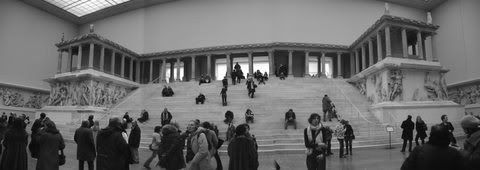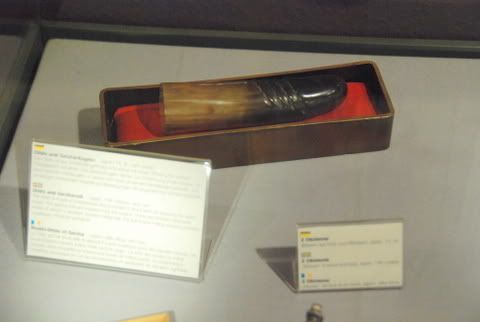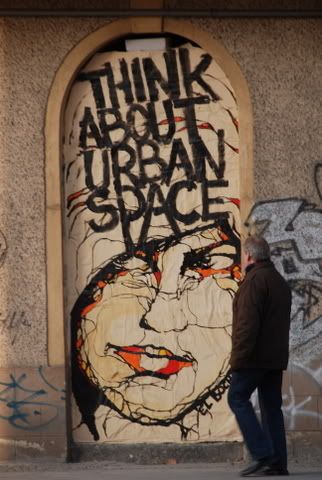Berlin for Christmas Time (2008.12.24-2008.12.31
For me inductive reflection is achieved best in active solitude.; walking upon unfamiliar ground and I’ve found other countries give me gems of information to reflect upon as I walk, often times because of their contrast to my “familiar” society in the United States. Other travelers also provide much intellectual fodder, much more so than at home, because there is a shared openness/vulnerability to travelers both far from home that allows chit-chat to be peeled away down to more substantial conversations.
I’m in Berlin, because of a cheap ticket; definitely not for the sub-freezing weather. For the last 10 years price has dictated where I travel and to some degree when. A lot of people get set on a destination and then are willing to spend spend spend to get there. I’m set on traveling, so when I have the time off of work(s) I start hunting for the cheapest thing to the farthest place and purchase. This cheapest farthest methodology I figure allows me to travel 2 to 3 times more than people that are destination travelers. A week long trip like this one to Berlin costs me under $800 for the whole kit and caboodle. A person planning a trip to Berlin from San Francisco could easily find themselves shelling out $1600 just to cover airfare and lodging. In comparison I’ve earned a free trip, by letting price dictate my demand.
Berlin is a city ripe with recent history and with a vibrantly blooming art scene; the type of thing you get in any major somewhat attractive city where there becomes a glut of housing that allows artists to move there. The fall of the Berlin wall less than a quarter century ago opened up East Berlin to a flood of housing and redevelopment of areas that the soviets had left as rubble piles that capitalism has quickly turned into architectural play grounds.
East Berlin: Marx and Engles (statues) look east as capitalism spins on.

I rolled into town on Christmas eve and was immediately struck by the architecture of the city and Berliner’s love of Christmas. The city set in black has monuments that glow in every shade of the rainbow and light up different times and building styles. In a 20 minute walk of Mitte you can find everything from Soviet wedding cake style apartment buildings lining Karl Marx Alee, to an architectural re-creation of Mt. Fuji floating apparently on the tops of 4 buildings. The ultra modern, the antique and even the ruins lie side by side. In some curious situations, such as the Reichtag, all three components can be found in one structure. The Reichtag use to be the seat of German parliament, but after some Nazi take overs, a big fire, some bombing etc., the building become well unfit for parliament. Also parliament at the time figured it was probably best not to have the decision making branch of Germany spitting distance from Soviets in Eastern Berlin, so most of the politicking got moved to Bonn for a period of time. Normon Foster a British architect took the bombed out building and rebuilt it from the inside with glass and capped the building with a glass dome and Parliament moved back in around 2000. Citizens walking up in the glass dome are able to stare right down at Parliament. Conceptually the building is a rebuttal to the Nazi take over of Parliament; the glass is to make the german politics transparent to everyone and the walkway above parliament is to symbolize that the citizens should always be held above the politicians. On the green side of things the building has 40% of it energy needs met by non-grid energy. Cooling and heating is taken care of by a shaft running 400m beneath the building where the ground temperature stays at a constant temp. The air is circulated up in to the building to take care of heating and cooling issues.
The bombed and rebuilt Reichtag

Other bombed out structures have not had the same sort of capital investment or fortune. Many squats dapple east Berlin that appear to have existed since the wall fell. Most of the squats are punk in nature, but also branch out to creative artists looking for cheap livings. The are as close in as a 10 minute walk to Mitte, but appears to grow in density as you head further east and north into Berlin. They are easily spottable by an increased density of graffiti, broken down vehicles, and the smell of camp fire in some cases. I tried wandering into a few of them to just look around and it looked like sustained camping in some cases. I found even the 40 year old punks with flopped Mohawks to be unusually friendly to someone like myself popping my head in.
Punk Squat: Kreuzberg

Graffiti is a major component of Berlin. Millions of people travel to Berlin every year to see the remnants of a torn down wall with a bunch of graffiti on it, so it seems only right that graffiti should have such a hold on the city as a whole. Graffiti runs the whole gamut from taggings, to murals, to historical markers and even advertisement of high end professionals. Near an old section of wall in Kreutzberg I saw a stencil on a man’s image and scrawled next to it “M. Lubbe, you won’t be forgotten.” I jotted down the name and checked it when I got back to the hospital. M. van Lubbe was a young communist partly member who was framed for the burning of the Reichtag that allowed the Nazi’s to gain control; Gestapo set up. Lubbe was tried, convicted, and executed. Only years later at the request of his family did the government admit that Lubbe could not have started the Reichtag fire and so cleared his name, but not his life. I enjoy historical tags like this, because it draws out the depth of history that is not always seen in the present. In Kruezberg I also saw something unimaginable in the US; a dentist office had the entire front of the building graffitied but in a manner that related to teeth. There was not sign on the building just the graffiti and a little bit of contact information. In the US this sort of high end job would never be seen mingling with the “dirty” or “low art” of graffiti.
East side and west side Berlin Graffiti in Kreuzberg

M Lubbe historical tag

The graffiti on the Wall is more moralistic as a whole, but over the years have gained a layer of new tags. The content of the new tags are very interesting. There is the common place taggers who are just trying to get the world to realize they exist, but the really interesting ones are those not drawing attention to themselves but to a group of people that are faced with a similar separation due to a wall (metaphorical) as Berlin once was. These tags ranged from Ireland, Israel, Palestine, Catalonia, Spain, etc. I see it as sort of physical geo-cashing of information. People that are visiting Berlin obviously have some interest in the fall of the wall, the breakdown of differences an restrictions, so these taggers are hitting a very receptive target audience with their call to metaphorical wall destruction in other parts of the world.
Berlin wall Mural - East side "gallery"

Ireland Tag on East Side Gallery Wall:

The hostel folk I met were an interesting mix of these sort of wall destroyers and just party kids. I spent the first couple nights at a hostel out in mid-eastern Berlin, where a met up with Josh Rossman. Josh was a former student of mine and has been studying abroad in Spain and just happened to have 2 days of overlap with me in Berlin. The stay at the hostel was cheap (7 Euro/night), but you had to put up with a French couple fucking in the room everytime you tried to fall asleep. This also hurt conversations with the other tenants of the room. Half way through the week I moved to a hostel more centrally located with smaller rooms and more engaging roommates. I had a very rich conversation with an Italian tennis coach/business man about the role of media in politics in the US and in Europe. In Italy almost all of the TV is controlled by 1 guy, who amazingly seems to just get re-elected and re-elected. I also had a good conversation about design with a girl from South Korea, Poa Boi.
Besides roaming the city street I did manage to wander into two museums. I visited the Pergamon, which yes if you remember right is a site in Turkey. Well the site in Turkey is missing an entire shrine and a lot of statues etc, because they are all in Berlin. The Pergamon museum also contains one of the arch ways from the entrance to Babylon and a lot of exquisite Islamic art. Some of the Greek statures are also impressive, as if there were the soul of a human in some of that stone and the Greeks had figured out how to trap them there. The flip side of the Pergamon was the Berlin Erotik Museum. The museum was started by a woman who was a pilot in WWII, when the Soviets came in she some how jacked a plane and flew out, seeing the market opportunities of East Berliner’s needs when the wall came down she set up shop in West Berlin, but instead of supplying pop culture or western trends she went a little deeper and longer into the market and found her niche in porn. This marketing positioning allowed her to become a millionare and so with some of that extra cash floating around she began to buy pieces of sex history and now has them all on display to be looked at. The Museum contains a lot of shunga art from 18C japan (paintings of sex scenes with giant genitalia), Victorian age pornographic paintings, and a whole host of other items. The one item that just blew my mind was a 18C tortoise shell dildo/vibrator. Talk about innovation. This thing was hollow on the inside and would be filled with a warm liquid and a series of heavy metal balls, as the piece was used the metal balls would knock into each other causing vibration….a vibrator 100 years before the first electric engine! All in all the museums of Berlin were impressive and more than I could possibly feel good about attending.
The Pergamon:

18C Japanese technology:

All in all the city is full of beauty, but not in a classical sense, but in seeing something in change and in flux. I waited to long to write this entry, so I’m going to cut off here with some other pictures of the trip:
Ferris Wheel at Alexander Platz

Kaiser-Wilheim bombed out church

Something Berlin is actively doing and something we should all do:

My Favorite Tree in Berlin:

See the whole album, geo-tagged and everything:
http://picasaweb.google.com/DamonTighe/200812Berlin#
No comments:
Post a Comment